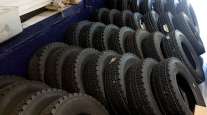Environmentalists Seek Tougher Standards for Heavy, Medium Truck Fuel Efficiency
This story appears in the Nov. 22 print edition of Transport Topics.
Environmental groups said they back the Obama administration’s push to set standards for heavy- and medium-duty truck fuel efficiency, and last week, they called for making the standards even tougher.
“The proposed rules represent a significant improvement and would put many of today’s existing technologies to work across the truck fleet by the year 2018,” Don Anair, a vehicle analyst with the Union of Concerned Scientists, said at a hearing on the proposed rules in Chicago. “But even greater savings are possible than proposed.”
The Environmental Protection Agency and the National Highway Traffic Safety Administration last month proposed truck and engine standards that would take effect between the 2014 and 2017 model years and would trim greenhouse gas emissions from large trucks by 7% to 20% (click here for previous story).
Anair and other advocates said the agencies also should regulate trailers to further improve fuel efficiency.
“When we’re looking at setting standards, we really need to look at the efficiency of the entire vehicle, and trailers are a critical piece to tractor-trailers,” he said. “We think it’s important to include those to make sure we’re really maximizing the benefit.”
Sierra Club’s Ann Mesnikoff said that the standards were “much needed,” but EPA and NHTSA should issue “stringent, technology-forcing standards.”
“We urge EPA and NHTSA to account for improvements on the entire vehicle and advanced technologies,” she said. “The focus on just tractor and engine improvements for longhaul freight trucks . . . limits the oil savings and CO2 benefits of the program.”
Trailer standards, Mesnikoff said, “should include aerodynamic improvements, options for lightweight materials and efficient tires” and should be finished in time for the 2014 model year.
When the agencies issued the rule, EPA Administrator Lisa Jackson said, the administration specifically avoided regulating trailers because trailer makers had little experience being regulated and the government had little experience dealing with them.
Anair said the proposal shows the agencies’ “intent to move forward with trailer regulations, and we support that,” but those regulations should be accelerated.
“Moving forward with [trailer] standards in the 2014 time period, the same as the truck standard, is a very doable proposal,” he told reporters when asked about Jackson’s statement. “I don’t think it is as quite complicated as you might be implying.”
Therese Langer, transportation program director for the American Council for an Energy-Efficient Economy, Washington, said that “there was substantial strengthening possible in this round of the rule.” She cited a study by the National Academy of Sciences that found fuel efficiency could be enhanced by as much as 50% using a variety of methods (click here for previous story).
Jed Mandel, president of the Engine Manufacturers Association, suggested that speed, truck size and weight, and congestion control should also be considered as ways to further efficiency.
He also said EPA and NHTSA should look at trailers, but only in a second round of regulation.
“Tractor-trailer units are an integrated system, combining engine drivetrains and transmissions, tractor and trailer design, and technologies and fuels,” he said. “EPA and NHTSA should recognize the potential need for a second-phase greenhouse-gas fuel-efficiency program, where there may be new opportunities for system optimization at a complete vehicle level.”
Randy Thomas, the associate director of the Illinois Trucking Association, told the agencies, on behalf of American Trucking Associations, that while the industry supports the rules as “a natural progression” toward increasing sustainability, there were some concerns.
“Some fleets have expressed concerns about specific equipment no longer being available for purchase or fleets being pressured to purchase equipment that may not achieve fuel-efficiency improvements in their specific work applications,” he said.
Thomas said some fleets are concerned about the possibility of “unintended consequences” from the rule, specifically about more fuel-efficient tires, which may increase stopping distance and more rapidly wear down pavement.




